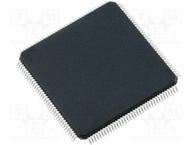Overview
●The LPC2388 is an ARM7 microcontroller for embedded applications featuring a high level of integration and low power consumption at frequencies of 72 MHz. Features include 512 kB of flash memory, 98 kB of SRAM, Ethernet MAC, USB Device/Host/OTG, DMA controller, 4 UARTs, 2 CAN channels, 3 SSP/SPI, 3 I2C, I2S, 8-channel 10-bit ADC, 10-bit DAC, 2 PWM, 4 general purpose timers, low power Real-Time Clock with separate battery supply, and up to 160 general purpose I/O pins. The LPC2388 is pin-compatible to the LPC177x Cortex-M3 MCU series.
●MoreLess
●## Features
● ARM7TDMI-S processor, running at up to 72 MHz
● Up to 512 kB on-chip flash program memory
● 64 kB of SRAM on the ARM local bus for high performance CPU access
● 16 kB SRAM for Ethernet interface. Can also be used as general purpose SRAM
● 16 kB SRAM for general purpose DMA use also accessible by the USB
● Dual Advanced High-performance Bus (AHB) system
● EMC provides support for static devices
● Advanced Vectored Interrupt Controller (VIC)
● General Purpose DMA controller (GPDMA) on AHB
● Ethernet MAC with associated DMA controller
● USB 2.0 device/host/OTG with on-chip PHY and associated DMA controller
● Four UARTs with fractional baud rate generation
● CAN controller with two channels
● SPI controller
● Two SSP controllers, with FIFO and multi-protocol capabilities
● Three I2C-bus interfaces
● I2S (Inter-IC Sound) interface for digital audio input or output
● SD/MMC memory card interface
● 104 General purpose I/O pins with configurable pull-up/down resistors
● 10-bit ADC with input multiplexing among 8 pins
● 10-bit DAC
● Four general purpose timers/counters
● One PWM/timer block with support for three-phase motor control
● Real-Time Clock (RTC)
● 2 kB SRAM powered from the RTC power pin
● WatchDog Timer (WDT)
● Standard ARM test/debug interface for compatibility with existing tools
● Emulation trace module supports real-time trace
● Single 3.3 V power supply (3.0 V to 3.6 V)
● Four reduced power modes: Idle, Sleep, Power-down and Deep power-down
● Four external interrupt inputs configurable as edge/level sensitive
● Processor wake-up from Power-down mode via any interrupt
● Two independent power domains allow fine tuning of power consumption
● Each peripheral has its own clock divider for further power saving
● Brownout detect with separate thresholds for interrupt and forced reset
● On-chip power-on reset
● On-chip crystal oscillator with an operating range of 1 MHz to 25 MHz
● 4 MHz internal RC oscillator trimmed to 1 % accuracy
● On-chip PLL
● Boundary scan for simplified board testing
●## Target Applications
● Industrial control
● Medical systems
● Protocol converter
● Communications
●## Features


